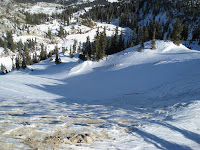UPDATE: Snowpulse was acquired by the Swiss company,
Mammut. These products are now referred to as: Mammut Avalanche Airbags.
Today I am introducing the Lifebag by
Snowpulse. This is the challenger (the Pepsi to ABS’ Coke…) they are much newer on the market and have the advantages and drawbacks that come with that. Because they are newer they don’t have as much of a track record but, on the other hand, as the late comer they are not lumbered with any legacy design commitments.
OVERALL DESIGNThe Lifebag is quite different in look; style and approach compared to the ABS System (see

picture to the left). It looks a lot like a life vest (hence the name I guess) and it is made of one bag that goes from your chest over your shoulders, neck and back down on the chest in one big sausage. The idea behind this design is to offer two advantages:
1) Offer protection against head and cervical trauma during a tumble.
2) Offer higher “flotation” and thus making your head (and airways) the part that stays the highest after the avalanche stops.
A statistic we often see is that, of the deaths resulting from a burial, 20% are due to trauma to the body in the fall (tree skiing anyone?). The shape of the Lifebag is supposed to offer some protection for the head, neck and thorax thanks to the location of the airbag in the shoulder straps. Considering the number of cases we would need to validate that statistically, let’s hope we never can. In addition to protecting your neck and head, it is supposed to offer a chance of leaving an air pocket in front of your airways, would you still find yourself buried once the avalanche stops. Snowpulse refers to this as “Head On Top technology” (HOT).
Although I don’t know of any independent testing of the Snowpulse, there is some independent corroboration for the functionality or design of this HOT concept. Avagear was a prototype of a product that consisted of a bag that wrapped around the head much like the Lifebag (that bag was only 90 L vs. 150 L for the LifeBag). In the 2001 tests by the Swiss Federal Institute for Snow and Avalanche Research (SLF) it was noted as follows:
“The fact that the faces of the dummies with the Avagear rescue vest were always found in the proximity of the surface appears to verify the hypothesis that the Avagear airbag, which is positioned close to the head, does indeed aid the lifting effect on the head and upper body. In fact two of the three Avagear-wearing dummies were found in an upright or seated position in the snow, whereas the dummies with the mono or dual airbag were found either face-up or facedown [sic] in a horizontal position.” (Davos, March 16, 2001, Martin Kern, Frank Tschirky, Jürg Schweizer, P.10)”
What remains to be seen in testing is if ABS’ argument that this upright position is a liability in terms of exposing the body " […] to the enormous dynamic forces within the avalanche […]” is a valid one. A trade-off that the Snowpulse user makes here is giving up some mobility but I am not sure how much that would matter as it is hard to assess what use we make of that mobility as we tumble in a pretty uncontrollable situation.
RELEASE SYSTEM
The handle is attached to the system and is stowed away in a zip pocket of the shoulder strap and therefore it can't come off, you can't lose it and you can't forget it either. This is not a completely trivial point as the bag will not be very useful without its launch mechanism…
FILL AND REFILLThe bag is inflated using a compressed air cylinder. Because Snowpulse uses a compressed air cylinder, it is refillable at your neighborhood scuba store.
SPECIFICATIONSTotal airbag volume: Volume of 150 L (about 38 gallons)
Weight:
The 15 L pack: 2525 g (5.6 Lbs) +/- 50 g cylinder included
The 30 L pack: 2925 g (6.4 Lbs) +/- 50 g cylinder included
The 45 L pack: 3225 g (7.1 Lbs) +/- 50 g cylinder included
GENERAL
In a statement from the company on 10/13/09 we learn that “The Snowpulse airbag has saved lives in the last years, we do have feedback from the victims, Pro Rider Nicolas Falquet, Mountain Guide Matthew Peter... More than 700 rescuers in Austria have also chosen the Snowpulse bag.” In Canada Eagle Pass Heliskiing and Pantheon Helisports use the LifeBag and provide one to each of their clients.
PRICINGHere again pricing is hard to get but I will have it by next week end and will post a comparative table. In general, the price range of the Snowpulse is similar to ABS System i.e. $950 – $1,200. The Snowpulse Lifebag, just like the ABS, is portable from one pack size to the other and an additional pack will add about $110.00 per unit.
A detailed comparative table of pricing including order information for these different vendors.
Hopefully, depending on if I hear back from BCA, Avalanche-pack face-off! (3 of 3) will be on the BCA Float 30.


























.jpg)














